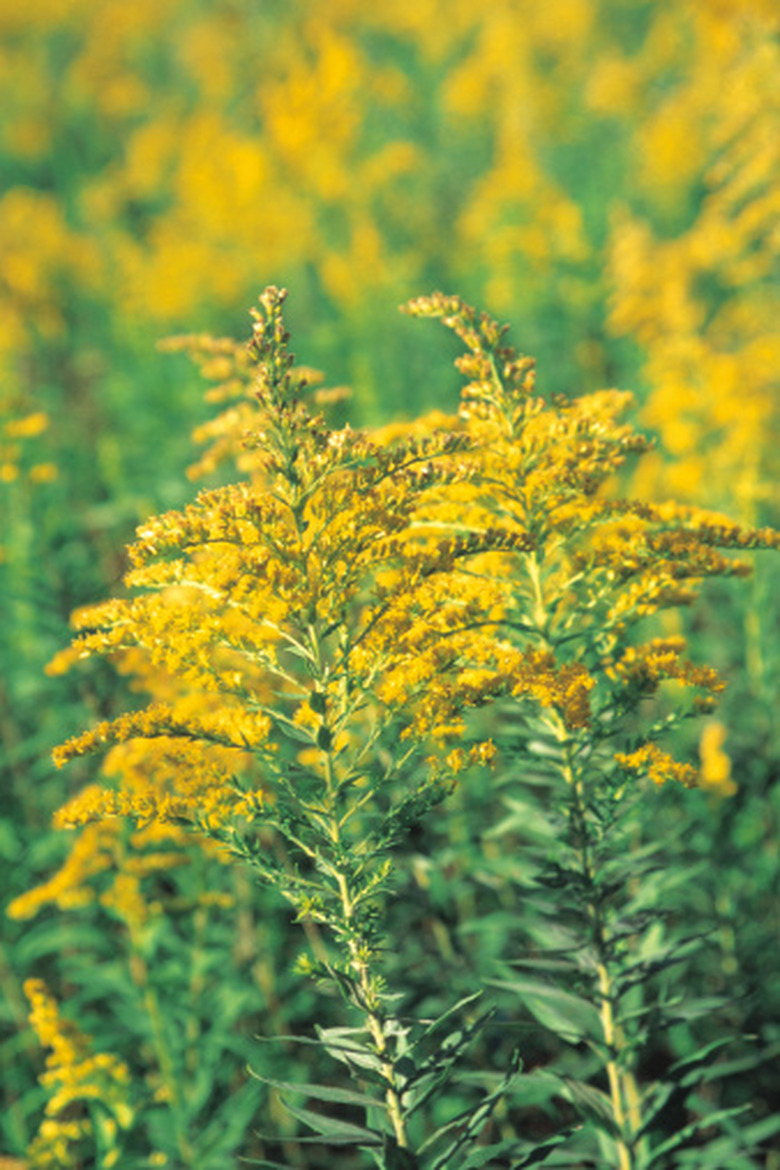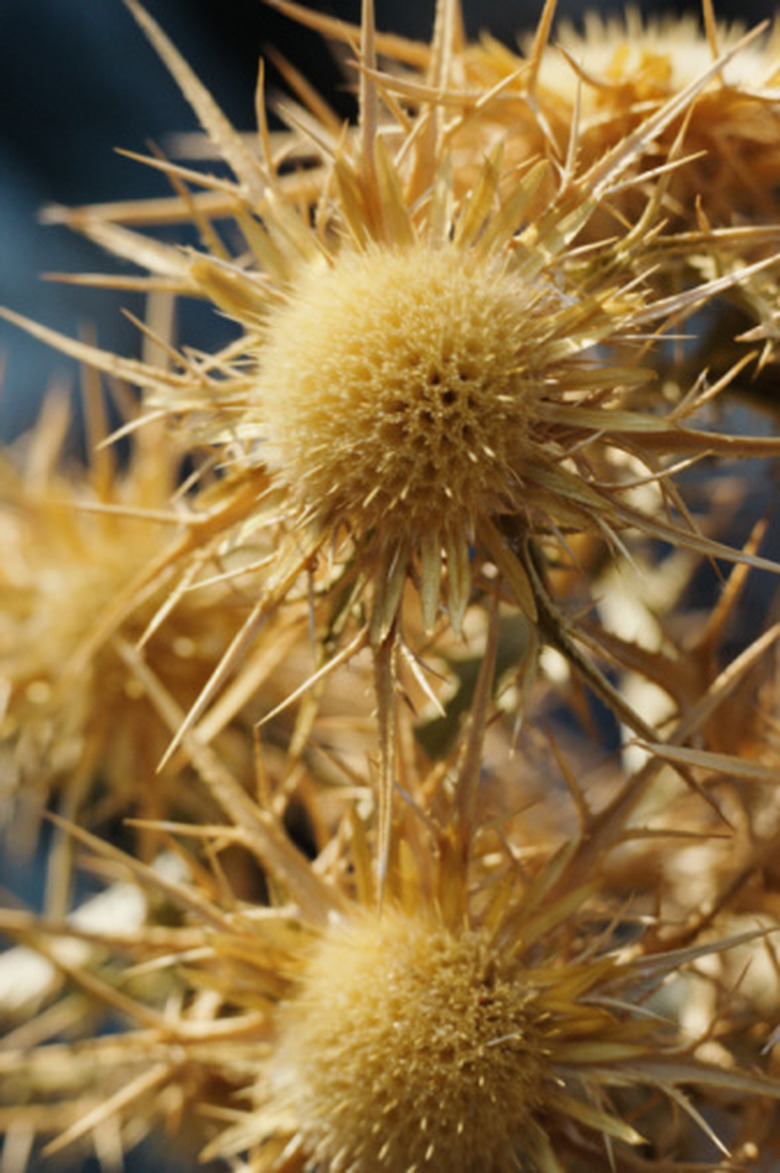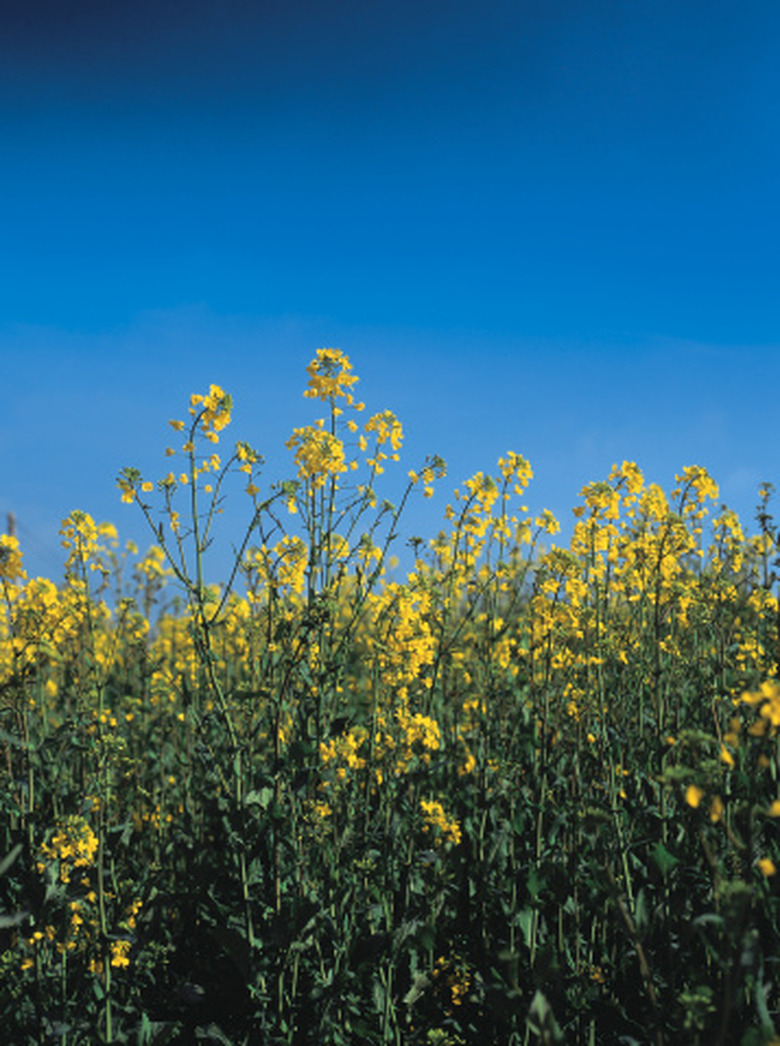Tall Weed With Yellow Gold Blooms Or Flowers
"Weed" can be defined from three perspectives: agricultural-ranching, suburban and ecological, according to the Illinois Wildflower Association website. In the suburban definition, a weed invades managed landscapes and is "well-adapted to its environment, prone to reproduce itself and spread, requires little or no effort to maintain, has no obvious aesthetic or culinary properties, and doesn't require money to acquire." Weed or wildflower, there are several plants that produce golden yellow flowers.
Thistlelike Yellow Weeds
Weeds or wildflowers can be identified by the color, shape and size of the flower. There are dozens of yellow weeds that are considered invasive and damaging to crop cultivation or pasture maintenance. Native to Eurasia, prickly sowthistle (Sonchus asper) is a tall, common weed found in pastures and open meadows, forest floors, ditches, beaches and beside lakes and stream beds. Introduced to North America through contaiminated seed, the plant now grows throughout the United States and Canada. Prickly sowthistle can reach heights taller than 6 feet. Yellow star thistle is an invasive weed that grows from 12 to 36 inches tall. The plant presents thistlelike bright yellow flowers with sharp, yellow spines located beneath the flower head. The leaves and stem are a dull, medium green, covered in fine hairs. Extremely invasive, this plant reproduces from seeds. A single plant can broadcast more than 150,000 seeds. Adaptable to most soils and growing conditions, the plant quickly can invade open meadows and range lands.
- "Weed" can be defined from three perspectives: agricultural-ranching, suburban and ecological, according to the Illinois Wildflower Association website.
- Adaptable to most soils and growing conditions, the plant quickly can invade open meadows and range lands.
Daisylike Yellow Weeds
Ragwort (Senecio spp.) presents clusters of bright yellow, daisylike flowers on 2- to 3-foot strong stems. The plant reseeds readily and can be found growing in clumps in meadows, pastures and roadside ditches. Huisache daisy, also known as honey daisy (Amblyolepis setigera) exhibits vivid yellow daisylike flowers and deep, bluish-green long leaves. The plant grows in clumps, 12 to 18 inches tall.
Useful Yellow Weeds
Common tansy (Tanacetum vulgare) presents dense heads of brilliant yellow flowers. Tansy grows in clumps and spreads rapidly. Early settlers planted tansy beside their cabins and outhouses to repel flies. Bunches of tansy also were cut and hung in windows and doorways to discourage insect infestations. An aromatic plant, tansy emits and essence that is not unpleasant to humans but that bugs find repulsive. Oxeye daisy (Chrysanthemum leucanthemum) is a hardy perennial used in landscape and found in the wild. The outer flower petals are white, surround a bright yellow flower disk. The edible, tender young leaves of the plant are used in salads and soups.
- presents clusters of bright yellow, daisylike flowers on 2- to 3-foot strong stems.
- Huisache daisy, also known as honey daisy (Amblyolepis setigera) exhibits vivid yellow daisylike flowers and deep, bluish-green long leaves.
Tallest Yellow Weeds
Spanish broom (Spartium junceum) is a herbaceous, perennial plant that presents vivid yellow, small flowers on almost leafless stems. The small green leaves are less than an inch in length. Spanish broom is highly fragrant, with a sweet, honeylike odor. Stems can grow to more than 10 feet tall. Considered invasive because of its ability to rapidly reseed, Spanish broom competes with and crowds out other native plants. Tansy ragwort (Senecio jacobaea) exhibits strudy stems that reach over 4 feet in height. Toxic tansy ragwort can kill horses, cattle and goats. It does not affect sheep. The plant presents small yellow blooms similar to a dandelion.
- Spanish broom (Spartium junceum) is a herbaceous, perennial plant that presents vivid yellow, small flowers on almost leafless stems.
- Tansy ragwort (Senecio jacobaea) exhibits strudy stems that reach over 4 feet in height.
Most Invasive Yellow Weeds
Garden loosestrife (Lysimachia vulgaris) exhibits clusters of small yellow flowers on tall stalks. Each flower has five petals. The plant spreads by rhizomes that form dense mats that crowd out other plants. The rhizomes are very tough and difficult to remove from the soil. Garden or common loosestrife flowers in July and August. Common St. Johnswort (Hypericum perforatum) grows from a deep taproot and reaches heights of 4 feet. It spreads rapidly, chokin-art.html'>choking out other native plants. Common St. Johnswort grows in USDA Plant Hardiness Zones 3 through 7. The plant presents woody stems with short, dark green leaves. The flowers are a bright yellow with five petals. Rush skeletonweed (Chondrilla juncea) is extremely difficult to eradicate. The plant produces tough, deep taproots up to 8 feet long and tiny yellow flowers on wiry, thin stems.
- Garden loosestrife (Lysimachia vulgaris) exhibits clusters of small yellow flowers on tall stalks.
- The rhizomes are very tough and difficult to remove from the soil.


